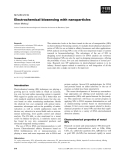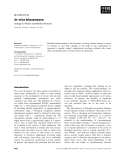
Biosensor applications
-
Objectives of the study: To find out about orientational CNTs and graphene material - the formation, methods of synthesis, properties and applications; optimization of technological conditions to produce high quality oriented CNT and graphene materials using the thermal CVD method.
 28p
28p  capheviahe27
capheviahe27
 23-02-2021
23-02-2021
 17
17
 3
3
 Download
Download
-
Study on modification/functionalization of conductive polymers using nanostructured materials (CNTs, Fe3O4 nanoparticles and Graphene) to develop the electrochemical biosensor and apply this biosensor in biomedical and environmental analysis.
 27p
27p  trinhthamhodang7
trinhthamhodang7
 31-08-2020
31-08-2020
 32
32
 2
2
 Download
Download
-
This minireview looks at the latest trends in the use of nanoparticles (NPs) in electrochemical biosensing systems. It includes electrochemical characteri-zation of NPs for use as labels in affinity biosensors and other applications. DNA analysis involving NPs is one of the most important topics of current research in bionanotechnology.
 7p
7p  inspiron33
inspiron33
 23-03-2013
23-03-2013
 49
49
 3
3
 Download
Download
-
Detailed understanding of the dynamics of living systems requires a means to monitor, in real time, changes in the levels of key components in response to specific stimuli. Applications involving cultured cells, tissue slices and implantation in living systems are discussed.
 10p
10p  media19
media19
 04-03-2013
04-03-2013
 21
21
 2
2
 Download
Download
-
The topoisomerase I (TopI) reaction intermediate consists of an enzyme covalently linked to a nicked DNA molecule, known as a TopI-DNA complex, that can be trapped by inhibitors and results in failure of re-ligation. Attempts at new derivative designs for TopI inhibition are enthusiastically being pursued, and TopI inhibitors were developed for a variety of applications. Surface plasmon resonance (SPR) was recently used in TopI-inhibition studies.
 9p
9p  toshiba23
toshiba23
 18-11-2011
18-11-2011
 49
49
 3
3
 Download
Download
CHỦ ĐỀ BẠN MUỐN TÌM


















